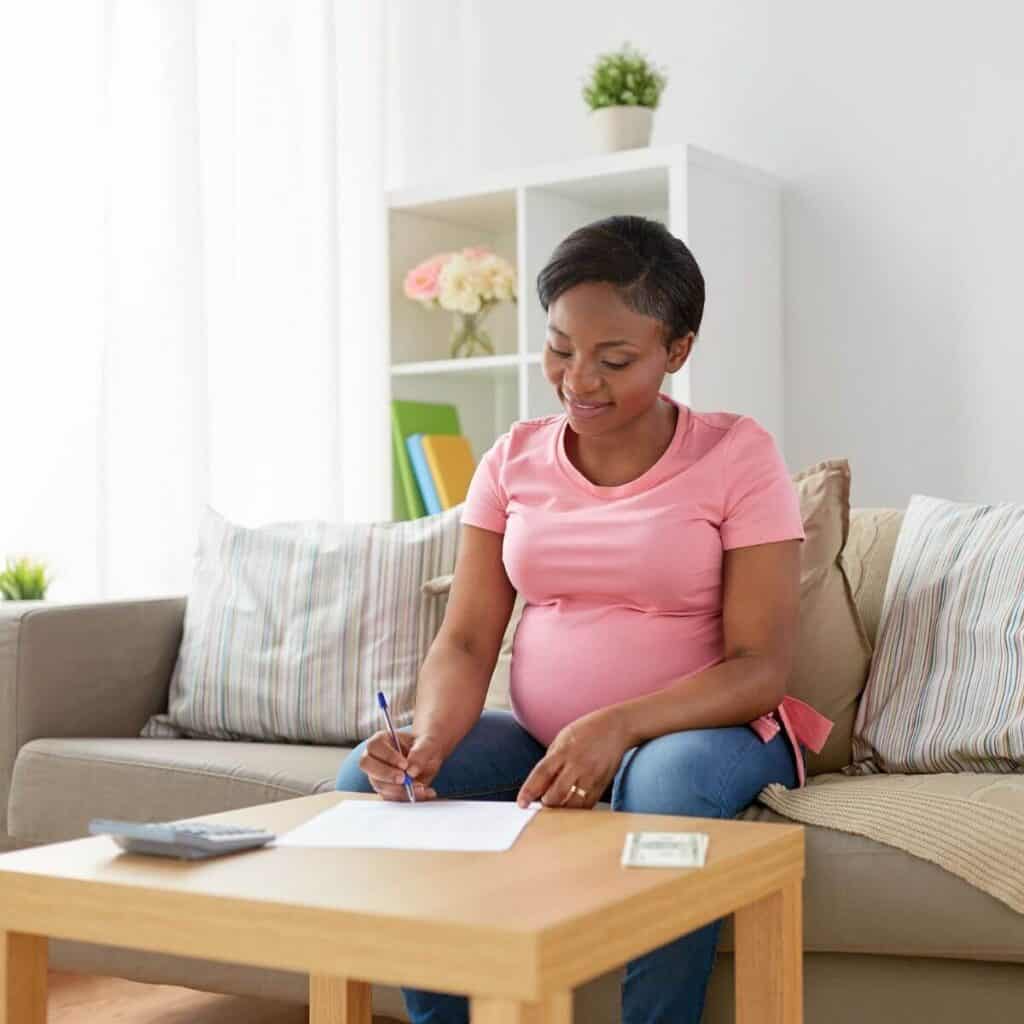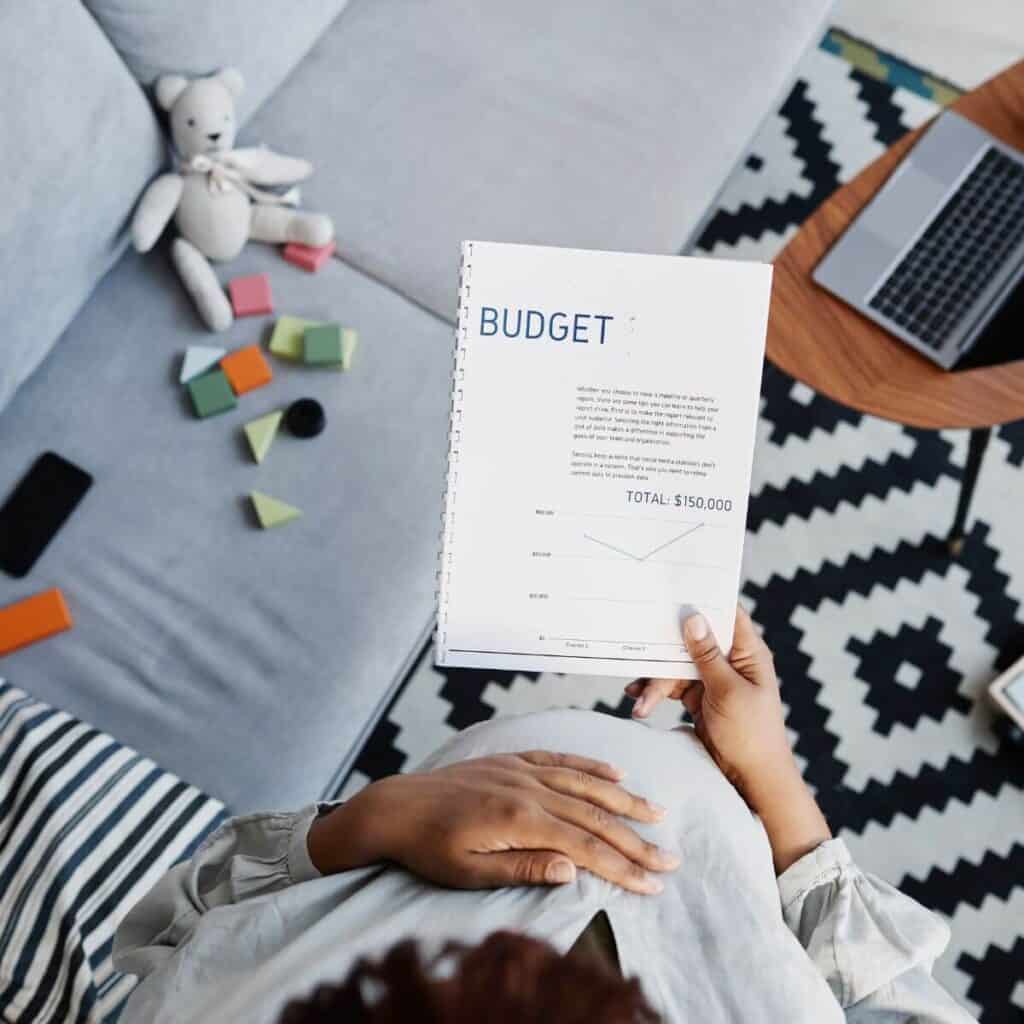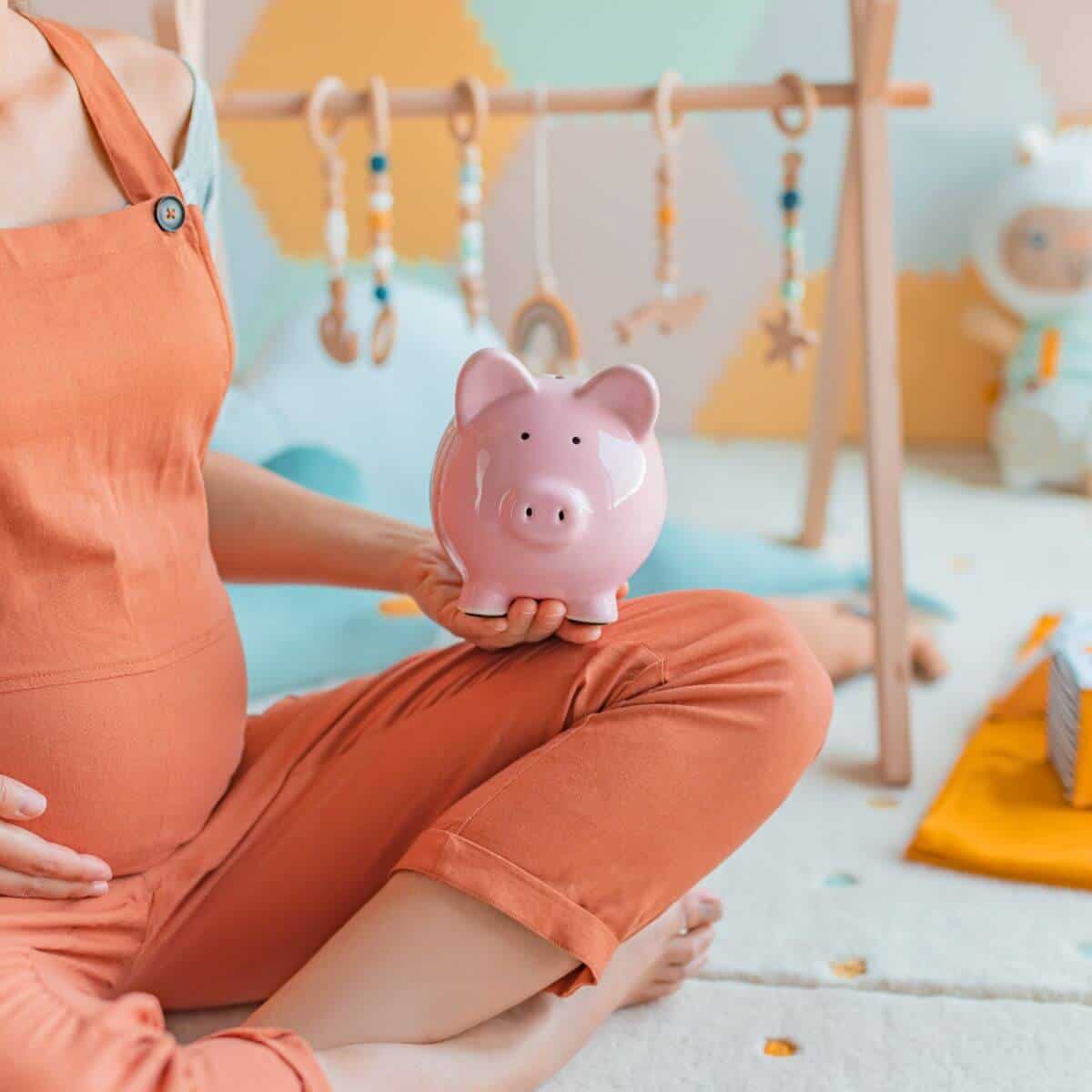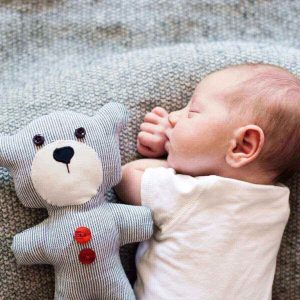With the price of baby goods on the rise, having a baby on a budget seems like an impossible task, but parents who avoid confronting these expenses are at risk of greater stress and anxiety.
Taking charge of your baby budget and staying on track is not only a major confidence boost, but financial mastery also promotes good mental health and warmer, more emotionally sensitive parenting from birth.
As a self-identified budget nerd, it’s my mission to help other new parents experience clarity and peace of mind knowing they’re money is spent on what truly matters to their family.
In this article, I share some potentially life-changing tips for creating a baby budget tailored to your unique interests and family dynamic, as well as how to get some pie-in-the-sky luxury baby gear at incredible prices. Let the budgeting begin!

This site contains affiliate links, meaning that we earn a small commission for purchases made through our site. We only recommend products we personally use, love, or have thoroughly vetted.
Create A Baby Budget With Values-Based Spending
Values-based spending is a method of budgeting that ensures you put as many dollars as possible toward the things you truly care about while cutting ruthlessly on things that don’t align with your values.
Whether you love attending the ballet, trying new restaurants, or making model trains, the things that give you happiness are priorities in a values-aligned budget.
Values-based spending is the foundation of any sustainable personal budget. It transforms the practice of budgeting from a painful chore to an empowering exercise in goal setting. Like a prudent gardener, you water the plants you want to thrive while starving the weeds.
Now let’s consider how values-based spending can optimize your new baby budget.
Before Starting Your Budget, Find Your Why
When you envision life with your new baby, what are you doing with them? And where? What images and ideas of new parenthood drive your excitement for this special and brief season of life?
What will you need to make these visions a reality? A rugged stroller for going on walks in the woods? A cleaning service during your maternity leave to maximize baby cuddle time?
Let your values determine your baby spending, and realize there will always be trade-offs. Do you love camping but could care less what baby wears? Solicit your parent friends for their old baby clothes, and put your precious dollars to use buying the highest-rated outdoor baby gear instead.
Value-based spending is spending you’ll always feel good about.
1. Setting Up A Budget
Once you’re clear on what matters to you (and your co-parent if you have one), it’s time to set your baby budget.
There are numerous budgeting tools on the market. My partner and I are obsessed with the budgeting tool YNAB as it helped us completely revamp our finances in less than 3 months before our first baby, but we also tracked expenses with a basic spreadsheet on Google Drive for years.
Whatever budgeting tool you use, start right away. The earlier you set your budget, the more time you’ve got to start saving for those big expenses and to locate freebies or second-hand items.
And if your work provides other benefits like short-term disability payments or an HSA/FSA that covers baby expenses tax-free, opt-in for those during open enrollment.
2. Planning For Expected Expenses
Many parents underestimate the financial toll of a baby, myself included! With the cost of raising a child rising every year, what is a realistic budget for a baby?
Expect to spend between $12,000 and $20,000 during your baby’s first year. Difficult-to-control costs like medical bills and childcare make up a significant chunk of those numbers, and it’s normal to feel some anxiety around baby expenses. It’s a seismic shift in financial priorities for most families!
If you’re feeling overwhelmed, remember there are many spending decisions well within your control. Get clear about what you value, and be choosy about how you spend. Let your budget hold you accountable and use the frugal tips I share later in this article. You can do this!
Here are some future expenses to consider when creating your baby budget. Use this list as a guide for planning ahead, but please know many of these purchases are entirely optional. Your budget is unique to you.
Prenatal Care
Good prenatal care is an essential component of baby care. This is the time to focus on your physical, mental, and emotional health, and that comes with its own set of expenses.
Your O.B. or midwife may require or recommend you purchase several prenatal care items. Additionally, , pregnant people benefit from a variety of prenatal services for managing pregnancy symptoms.
Many of these products and services are helpful after birth and well into the fourth trimester. It’s not likely you’ll want or even have time for all these things. Consider the products and services listed below, and select a few must-have items for your budget:
- Supplements (Prenatal Vitamins, Iron, DHA, Probiotics, etc.)
- Out-Of-Pocket Medical Costs
- Pregnancy Planner
- Doctor-Prescribed Medications
- Prenatal Fitness Classes
- Birth Education Classes
- Webster-Certified Chiropractors
- Prenatal Massage
- Prenatal Lactation Classes
- Nutritionist Consultation
- Acupuncture
- Pelvic Floor Therapy
- Mental Health Services
- Pregnancy Photographer (to capture that fleeting baby bump!)
- Maternity and Labor Outfits (including Maternity shoot outfits)
Baby Gear
Your baby gear purchases will make or break your baby budget. The sheer variety and range of prices for baby products is dizzying, and for new parents, it’s difficult to know what products you need.
Some things you cling to like a life raft through the turbulent waters of early parenthood. Others sit unopened, silently guilt-tripping you for all the money you wasted. If this happens to you, it’s totally normal. Try using our baby registry must-haves to narrow things down.
To pair down expenses, go back to those values we discussed at the beginning. Ask yourself the following questions:
- Does this fit into our current lifestyle or how I envision our new life with a baby?
- Am I excited to use this or am I indifferent?
If you’re not 100% certain about a product, delay buying it until after the baby comes. It’s easy to order things online but so hard to get them out of your house.
Consider the list below before adding (or eliminating) items from your baby budget:
- Bassinet
- Crib
- Crib Mattress
- Changing Table
- Changing Pad
- Swaddles or Sleep Sacks for Babies
- Infant Monitors
- Clothing
- Burp Cloths
- Bibs
- High Chair
- Baby Tableware
- Seasonal Items (Jackets, Sun hats, etc.)
- Nursery Decor and Paint
- Nursery Dresser
- Rocking Chair
- Baby Toys
- Play Gyms
- Books
- Rockers or Bouncers or Swings
- Diaper Bag
- Diaper Bin
- Cloth Diapers
- Car Seat
- Stroller
- Babywearing Carrier
- Bottles
- Bottle Cleaning Supplies
- Bottle Warmer
- Breast Pump (if not covered by insurance)
If you’re looking for the bare minimum needed to make it through that newborn phase, check out our minimalist newborn essentials.

Ongoing Baby Purchases
The list above includes many one-time expenses, but you also want to plan for recurring monthly or semi-monthly purchases. (Think key supplies like diapers, wipes, and formula).
Putting a little cash towards these expenses every month helps you stay on budget, especially during those weeks when you run out of everything all at once. (I’ll never forget the 2-day wipe famine of 2019).
Before the baby comes, clear out space in your kitchen, empty some baskets or shelves, and find a nice clean container for your fridge. You’ll feel like you have it all together (even for just a moment) when your new baby products fit seamlessly into your storage areas from the beginning.
Finally, don’t be afraid to experiment a bit with different baby products before fully committing to a particular brand or formulation. On the flip side, if you’re absolutely in love with a product, then stick with it!
Honestly, that goes for everything you do during a baby’s first year. Even if your favorite celebrity influencer swears by something else, if it’s working for you, there’s no need to change it.
Take a look at these common ongoing expenses for your new baby:
- Disposable Diapers
- Diaper Bin Trash Bags
- Wipes
- Diaper Cream
- Baby Soap + Shampoo
- Gentle Laundry detergent
- Formula
- Water For Mixing Formula (If Your Tap Water Is Unsafe)
- Breast Milk Storage Bags
- Vitamin D Drops
- Nipple Cream
- Replacement Breast Pump Parts
Postpartum Expenses
Postpartum expenses are easily overlooked in the excitement of birth and a new baby, but this is also the most stressful period for handling unplanned expenses. Depending on your employer’s policies, you may also be confronting several months of reduced income.
Use a postpartum plan template to prompt discussions about your care and recovery needs with a partner or family members. Don’t be afraid to ask for help in advance from your circle of friends and family or even hire professionals. It’s been my number one priority with my second pregnancy.
When it comes to meals, consider a mix of postpartum meal prep, meal trains hosted by friends or family, and takeout. In the first forty days of recovery, your family will need around 42 dinners, and trust me, after a single night of trying to cook through the baby’s witching hour, you will understand why meal planning is critical to thriving postpartum.
Here’s a list of postpartum expenses worth factoring into your baby budget:
- Labor + Delivery Bills
- Medical (Check-ups for Mom and Baby, Lactation, Pelvic Floor, Postpartum Doula)
- Take-Out Meals
- Cleaning Services
- Postpartum Clothes (Postpartum pajamas, nursing bras, etc.)
- Postpartum Doula or Night Nurse
- Lawn Care/Home Maintenance Services
- Childcare/Babysitting/Nanny
- Emergency Medical Expenses
- Mental Health Therapist Visits
- Postpartum Supplements
3. Save Money Buying Second-hand
As a first-time mom, I wanted all the perfectly pristine new products for my perfectly pristine angel baby. Unfortunately, I paid a high premium for items that quickly stained, wrinkled, warped, or simply sat collecting dust. As a second-time mom, I shout at the top of my lungs to anyone listening, “BUY USED!”
Unless you’re planning to have many more children, it’s tough to get enough value out of short-lived products like bouncers or baby clothes purchased new. This also applies to your maternity and postpartum wardrobe.
Start searching as early as your second trimester on second-hand marketplaces like Facebook Marketplace, ThredUp, Mercari, Ebay, Poshmark, OfferUp, or Rebel Stork. Also check out physical store locations like Goodwill, Salvation Army, or Kid to Kid. The amount you can save might shock you.
How I Saved 76% Off The Cost of New Baby Gear Buying Second-Hand
If you’re still not convinced second-hand is the way to go, let me share a personal example. Below is a list of real items I purchased for our new baby in 2023. The amount I saved by buying used versus new blows my mind!
| Baby Products | Price Paid | Purchased From | Total Savings |
| Stokke Tripp Trapp Chair | FREE | Facebook Marketplace | $220 |
| Skip Hop Baby Bath Tub | $3 | Goodwill | $37 |
| Woolino Basic Sleep Sack | $41 | Facebook Marketplace | $39 |
| AMKE 3 in 1 Bassinet | $70 | Facebook Marketplace | $139 |
| IKEA GULLIVER Changing Table | $70 | Facebook Marketplace | $60 |
| Diaper Genie Complete | FREE | Buy Nothing Group | $48 |
| UppaBaby Vista Stroller + Rumble Seat | $250 | Facebook Marketplace | $950 |
| B.O.B. Revolution SE Single Stroller | $100 | Craigslist | $400 |
TOTAL SPENT: $534
TOTAL COST IF PURCHASED BRAND NEW: $2,247
TOTAL Savings on Second-Hand Baby Goods = $1,713
As you can see, I have a taste for high-end baby items, but when it comes to our values-based spending approach, I want more of my money going towards things I value like travel, family outings, and retirement.
Shopping second-hand helps me find that happy medium between luxury and frugality.
Also, I don’t have hours to spend scouring the web for the best deals. These items are all the result of a few quick searches in a 20-mile radius and took about the same amount of time as going to a store to purchase something new. You don’t need special skills or lots of free time to save on baby stuff!

How To Find Second-Hand Baby Products Absolutely FREE
The Buy Nothing Project is a global community made of many local groups where members give items and services absolutely free. They promote generosity, neighborliness, and environmental sustainability.
Buy Nothing Groups are a fantastic resource for finding free used (and sometimes new) baby gear. Groups are hosted on various social platforms. Check their website to find a local group near you.
The earlier you join, the more opportunities you have to snag amazing baby stuff. Here’s a list of items recently gifted in my local 400-member Buy Nothing Group:
- New, Unopened Baby Formula
- Crib Sheets
- 100% Muslin Cotton Swaddling Blankets
- Baby Clothes
- Baby Toys
- Maternity Clothing (Including Breastfeeding Tops)
- Crib Mattress Covers
- Nursery Furniture like Dressers or Changing Tables
If you don’t have a Buy Nothing group near you, don’t worry! There are plenty of companies offering baby-related freebies. Many parents also join or start their own baby gear swaps. Swaps are fantastic for sharing and receiving items that babies size out of quickly including clothes, cloth diapers, strollers, bouncers, and more!
Some Items Are Best Purchased New
Car seats are one of the few baby items best-purchased brand new. For example, any car seat installed during a vehicle accident is no longer safe and must be removed and discarded.
This is why the American Academy of Pediatrics recommends only purchasing car seats with a known history, ideally straight from the store, manufacturer, or maybe a close trusted friend.
Second-hand car seats may be affected by product safety recalls, and without a purchase record, manufacturers cannot alert you to possible safety hazards. In addition, second-hand car seats can be sold beyond their expiration dates, and many hospitals won’t let you leave with your baby if you’re using an expired car seat.
Parents should also use caution when purchasing a baby sleeping environment including second-hand bassinets, cribs, and other types of sleepers. Due to the risk of SIDS, any sleeping space must be assessed for durability, stability, and safety. Never buy a baby sleep device sight unseen and research the product for previous safety recalls.
How to Save When You Have to Buy New
Fortunately, there are ways to save money on brand-new baby products too! Scroll through your favorite baby brand’s social media page and take note of any big annual sales events. Sign up for their email newsletter to receive discount offers if you need to buy right away.
Keep in mind a higher price does not equal a higher safety rating. Search Baby Gear Lab for detailed articles comparing price to functionality and safety.
4. Be Strategic With Your Baby Registry
My last frugal tip is all about optimizing your baby registry. Registries are key to saving money on your baby’s first year, especially for first-time parents. You may only get one baby shower, so work it!
Include a selection of items in all price ranges, especially plenty of $5-$15 items that make great last-minute add-ons. People often have their own spending limit for gift-giving and are happy to throw in a few extras if it’s in the budget. Baby clothes, bath toys, stuffies, teethers, pacifiers, baby tableware, bibs, bows, and even first aid items are affordable “cart stuffers” for your registry.
Take the time to register with multiple companies to take advantage of their registry-free welcome baskets. Use a centralized online registry like Babylist if you plan to ask for specialty items or products from small businesses.
Also, consider adding professional services to your registry to help lighten your mental load. This brilliant tip came from our founder Katy’s top baby registry hacks!
Don’t forget to add items from your list of recurring expenses like diapers, wipes, formula, and bath or body products. We saved a ton on diapers in my son’s first year thanks to the generosity of our family and friends!
Stress Less When You Plan For Baby on a Budget
Having a baby on a budget requires a little planning, some self-reflection, and even a few trade-offs, but it’s so worth it!
By establishing a values-based budget, you know your money is going toward things that are meaningful and useful to your family. You also know there’s always money set aside for essentials. It’s a great feeling!
There are many avenues for fitting even the most expensive tastes into the tightest budgets, and I hope the examples I shared encourage you to explore money-saving options on the latest baby gear. I can’t wait to hear about all the good deals you snap up!
Are you also preparing financially for a new baby? Share your own frugal tips for having a baby on a budget!










